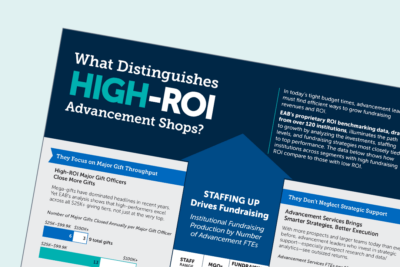Scaling and Sustaining Principal Gift Success
Use this white paper to learn about development office staffing to deliver high-touch donor experiences sustainably over the long term and seize new opportunities for transformative giving.
23%
Principal gifts have grown more important to advancement across the past decade due to rapid post-recession growth at the top of the wealth spectrum. There is concern among advancement about how to best manage and capitalize on this growth, especially given that most principal gift operations were built decades ago to cultivate a small group of families very deeply.
Doubling Down Pays Off: Institutions With at Least One 7-Figure Gift
In the past 10 years, advancement organizations have realized that opportunity. Just 56% of institutions received at least one gift of $1 million or more in 2010, but by 2018 that number had risen to 67%.
To build principal gift programs suited to the vast array of opportunities available in today’s principal giving landscape, best practice institutions identified in our research have begun reimagining their development office staffing programs in two ways: scaling the reach of the CAO and enfranchising early-career gift officers to cultivate “cold” principal gift donors.
Two Strategy Shifts for the Decade Ahead

Scale the CAO’s Reach
Staffing strategically to find economies of scale

Flip the Talent Paradigm
Enfranchising new gift officers to cultivate the pipeline
Scale the CAO’s reach
Related Webconference
Scale and sustain principal gift success
Watch the VideoAdvancement leaders at many institutions have been forced to deal with a paradox when it comes to principal gift donor management. Our most complicated and precious relationships are managed by the busiest people on campus, including the CAO.
Principal gift donors are highly involved and require high-touch cultivation. However, the CAO, the president, the engineering dean, or whoever else is owning the relationship all have minimal time to devote to each of their prospects. In the previous era of small-scale principal gift operations, this donor management model got the job done, but it is now reaching its breaking point.
Case Study: Dalhousie University in Nova Scotia, Canada
- Goal: To ensure that their CAO could broaden his reach to maximize impact with donors
- Solution: Rethink development office staffing. Hired a principal gift strategy manager who now handles the pre-work necessary for principal gift cultivation, giving the CAO more time with high-ROI donors
Flip the talent paradigm
A growing number of institutions are starting to flip the traditionally CAO-centric talent paradigm and put earlycareer fundraisers or recent hires in front of principal gift prospects. That’s happening because who we identify as a prospect is starting to grow.
Whereas the principal gift relationships of the past—our deepest, longest-standing relationships—always merited a senior executive’s touch, many of today’s prospects are “cold”, having little to no engagement with or giving to the university. At present, these prospects don’t merit the CAO spending much time trying to land a discovery visit.
Case Study: UC Davis
Builds portfolio focused on those with low engagement
- 40 prospects currently managed
- Little to no engagement or giving to the university
- One director of development assigned
- Responsible for entire cultivation cycle
- $20M expected through new gifts and commitments for FY2020
Case Study: University of South Dakota
Early career fundraisers engage in principal gift discovery blitz
- 14 fundraisers
- One in three principal gift discovery officers had zero years of experience
- 57% of gifts closed by early career staff in year one
These high-net-worth, unengaged donors don’t fit into our traditional principal gift staffing paradigm, and they’re starting to break the model. The principal gift staffing challenge CAOs face today is how to build a program that can steward the most important relationships while simultaneously developing a pipeline of new principal gift prospects who could quickly move towards a transformative gift without decades of cultivation.
“When principal gift programs were first established in the 80’s they typically focused on 20-30 couples and individuals whose interest and devotion to an organization made them stand out among other supporters…30 years later that focus seems impossible given the number of wealthy individuals.”
Rebecca Tseng Smith
Senior Executive Director of Development
University of California, San Diego
More Resources

Corporate and Foundation Relations

What distinguishes high-ROI advancement shops?
